| Listing 1 - 10 of 168 | << page >> |
Sort by
|
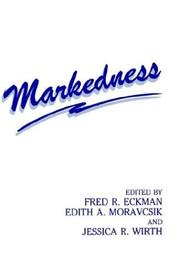
ISBN: 0306423723 1441932054 1475757182 Year: 1986 Publisher: New York
Abstract | Keywords | Export | Availability | Bookmark
 Loading...
Loading...Choose an application
- Reference Manager
- EndNote
- RefWorks (Direct export to RefWorks)
Linguistics --- Markedness (Linguistics) --- Marque (Linguistique) --- Congresses --- Congrès --- -Marked member (Linguistics) --- Distinctive features (Linguistics) --- Generative grammar --- Grammar, Comparative and general --- -Congresses --- Congresses. --- Congrès --- Marked member (Linguistics)
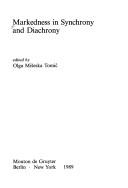
ISBN: 3110117800 3110862018 9783110117806 Year: 1989 Volume: 39 Publisher: Berlin: Mouton de Gruyter,
Abstract | Keywords | Export | Availability | Bookmark
 Loading...
Loading...Choose an application
- Reference Manager
- EndNote
- RefWorks (Direct export to RefWorks)
No detailed description available for "Markedness in synchrony and diachrony".
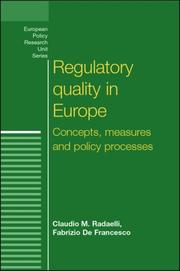
ISBN: 9781847792310 1847792316 9780719074042 0719074045 1781701571 9781781701577 Year: 2007 Publisher: Manchester : Manchester University Press,
Abstract | Keywords | Export | Availability | Bookmark
 Loading...
Loading...Choose an application
- Reference Manager
- EndNote
- RefWorks (Direct export to RefWorks)
The European Union and its member states are investing in ambitious programmes for 'better regulation' and targets of regulatory quality. This book lifts the veil of excessively optimistic propositions covering the whole better regulation agenda. It provides an innovative conceptual framework to handle the political complexity of regulatory governance. It approaches better regulation as an emerging public policy, with its own political context, actors, problems, rules of interaction, instruments, activities and impacts. Focusing on the key tools of impact assessment, consultation, simplificati
Administrative procedure --- European Union. --- better regulation. --- consultation. --- impact assessment. --- member states. --- public policy. --- regulatory governance. --- regulatory quality. --- rules of interaction. --- simplification.
Book
ISBN: 9783110623093 9783110622287 9783110618402 3110622289 3110623099 3110618400 Year: 2019 Publisher: Berlin Boston De Gruyter
Abstract | Keywords | Export | Availability | Bookmark
 Loading...
Loading...Choose an application
- Reference Manager
- EndNote
- RefWorks (Direct export to RefWorks)
This volume presents new and cutting-edge research on the question of how we parse, interpret and understand language in more complex discourse settings. The challenge is to find empirical evidence on how information structure and semantic processing are related. Comprehensible answers are provided by showing how syntax, phonology, semantics and pragmatics interact and how they influence semantic processing and interpretation. The analysis of core information structural concepts that contribute to processing such as focus and contrast, the specific discourse status of referents that add to the common ground, context dependency and markedness as well as prosodic prominence and givenness marking has added new and convincing evidence to the research of information structure and semantic processing.
Markedness (Linguistics) --- Marked member (Linguistics) --- Distinctive features (Linguistics) --- Generative grammar --- Grammar, Comparative and general --- Linguistics --- E-books --- Information structure. --- language processing. --- pragmatics. --- semantics.
Book
ISBN: 1781701636 1847792375 9781847792372 9781781701638 9780719078828 0719078822 Year: 2008 Publisher: Manchester, U.K. ; New York : New York : Manchester University Press ; Distributed exclusively in the USA by Palgrave MacMillan,
Abstract | Keywords | Export | Availability | Bookmark
 Loading...
Loading...Choose an application
- Reference Manager
- EndNote
- RefWorks (Direct export to RefWorks)
Can Russia, the European Union and the three major EU member states adopt a unified policy line in the global arena? Charlotte Wagnsson investigates the cohesiveness of 'greater Europe' through the detailed scrutiny of policy statements by the leadership elites in the UK, France, Germany, Russia and the EU in connection with three defining events in international security: the crisis in Kosovo of 1999; the terrorist attacks of 9/11 and the Iraq crisis of 2003. This extensive empirical enquiry results in a critical constructivist response to neorealist understandings of European security. The b
Security, International --- 9/11. --- EU member states. --- European Union. --- Iraq. --- Kosovo. --- Russia. --- greater Europe. --- international security. --- leadership elites. --- policy statements. --- terrorist attacks.

ISBN: 9027724059 9401086281 9400947984 Year: 1987 Volume: vol 29 Publisher: Dordrecht Boston Tokyo Reidel
Abstract | Keywords | Export | Availability | Bookmark
 Loading...
Loading...Choose an application
- Reference Manager
- EndNote
- RefWorks (Direct export to RefWorks)
Berkeley, George --- #GROL:SEMI-1-05'17' Berk --- Berkeley (George). --- G. B. --- B., G. --- Berkley, George, --- Author of The minute philosopher, --- Minute philosopher, Author of the, --- Cloyne, --- Berkeley, --- Member of the established church, --- בערקלי, דזשארדזש, --- Author of Siris,
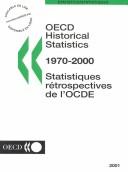
ISBN: 9264087141 9264097600 9789264087149 Year: 2001 Publisher: Paris, Cedex, France : OECD,
Abstract | Keywords | Export | Availability | Bookmark
 Loading...
Loading...Choose an application
- Reference Manager
- EndNote
- RefWorks (Direct export to RefWorks)
This publication provides an overview of the economic development of the member countries of the OECD since 1970. The tables mainly show derived statistics such as growth rates and percentage shares. Coverage includes national accounts, population and labour force, prices and domestic finance, as well as international trade with OECD and groups of non-member countries. This is the last edition of this book that will be published.
Economic history -- 1945- -- Statistics -- Periodicals. --- Economic history -- 1945- -- Statistics. --- Economic history -- 1945-. --- Economic history --- OECD countries --- Economic conditions --- Economic policy --- History, Economic --- Economics --- OECD member countries --- Organisation for Economic Co-operation and Development countries
Book
ISBN: 9781547400270 1547400277 1547400382 1547416440 Year: 2018 Publisher: Boston ; Berlin : De|G Press,
Abstract | Keywords | Export | Availability | Bookmark
 Loading...
Loading...Choose an application
- Reference Manager
- EndNote
- RefWorks (Direct export to RefWorks)
Boards of directors are sitting ducks. Shareholders complain and even attack, management manipulates, and individual board members have little power, able to act only as part of the board as a whole. Governance issues are front and center, yet there is often little understanding, even among board members, of the key role that they play. Written in an accessible and human voice, The Governance Revolution: What Every Board Member Needs to Know, NOW! provides information and context essential to anyone seeking to understand how corporations and their stewards-the board of directors-can and should function in the volatile world we inhabit. Deborah Hicks Midanek offers useful insight into what board members of corporations actually do, the current standards for board members and why they exist. She includes a timely discussion of how clarity of purpose can improve board and director effectiveness. Informed by her long experience serving public, private, and family owned corporate boards as well as those of charitable, and government organizations, she provides essential context regarding the evolution of board practice as well as candid discussion of the issues involved in the relentless effort to improve corporate governance processes. Focused mainly on the dominant public corporation, she also explores the special challenges of serving private and family owned as well as nonprofit and public agency boards. Written by a seasoned board member, and liberally laced with stories and cases illustrating the tricky issues directors wrestle with, this book is the essential common-sense companion for anyone working with a board, serving on a board, or wanting to do so. Directors, aspiring directors, investors, and students of corporate behavior will benefit from this highly readable description of the cloistered boardroom. For Roger Trapp's article in Forbes featuring a discussion of this title click here https://www.forbes.com/sites/rogertrapp/2018/10/22/independent-directors-nehttps://www.forbes.com/sites/rogertrapp/2018/10/22/independent-directors-need-to-stand-up-to-activists/#7060008826b0ed-to-stand-up-to-activists/#7060008826b0 For a Roundtable discussion in Financier Worldwide Magazine featuring Deborah Hicks Midanek please click here https://www.financierworldwide.com/roundtable-risks-facing-directors-officers-aug18#.W1BqQdVKiUk Click here for a review in Financial Analysts Journal https://www.cfapubs.org/doi/abs/10.2469/br.v13.n1.10
Boards of directors --- Corporate governance --- Governance, Corporate --- Industrial management --- Directors of corporations --- Boards of supervision (Corporation law) --- Associations, institutions, etc. --- E-books --- Corporate governance. --- Boards of directors. --- Board Member. --- Board of Directors. --- Board. --- CEO. --- Director. --- Governance.
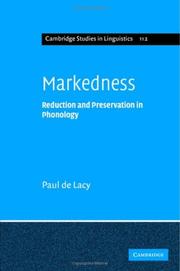
ISBN: 0521839629 9780521839624 9780511486388 9780521142236 0511241623 9780511241628 9780511242359 0511242352 0511240589 9780511240584 0511241100 9780511241109 0511486383 9786610568062 6610568065 1107162556 1280568062 0511318456 0521142237 Year: 2006 Publisher: Cambridge ; New York : Cambridge University Press,
Abstract | Keywords | Export | Availability | Bookmark
 Loading...
Loading...Choose an application
- Reference Manager
- EndNote
- RefWorks (Direct export to RefWorks)
'Markedness' refers to the tendency of languages to show a preference for particular structures or sounds. This bias towards 'marked' elements is consistent within and across languages, and tells us a great deal about what languages can and cannot do. This pioneering study presents a groundbreaking theory of markedness in phonology. De Lacy argues that markedness is part of our linguistic competence, and is determined by three conflicting mechanisms in the brain: (a) pressure to preserve marked sounds ('preservation'), (b) pressure to turn marked sounds into unmarked sounds ('reduction'), and (c) a mechanism allowing the distinction between marked and unmarked sounds to be collapsed ('conflation'). He shows that due to these mechanisms, markedness occurs only when preservation is irrelevant. Drawing on examples of phenomena such as epenthesis, neutralisation, assimilation, vowel reduction and sonority-driven stress, Markedness offers an important insight into this essential concept in the understanding of human language.
Grammar, Comparative and general --- Markedness (Linguistics) --- Marked member (Linguistics) --- Distinctive features (Linguistics) --- Generative grammar --- Linguistics --- Phonology --- Phonetics --- Phonology. --- Arts and Humanities --- Language & Linguistics --- Philology --- Grammar, Comparative and general Phonology
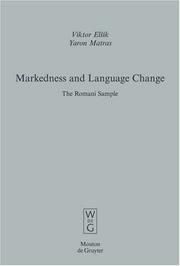
ISBN: 3110184524 9783110184525 3110197596 9783110197594 1282193961 9786612193965 9781282193963 Year: 2006 Publisher: Berlin ; New York : Mouton de Gruyter,
Abstract | Keywords | Export | Availability | Bookmark
 Loading...
Loading...Choose an application
- Reference Manager
- EndNote
- RefWorks (Direct export to RefWorks)
'Markedness' is a central notion in linguistic theory. This book is the first to provide a comprehensive survey of markedness relations across various grammatical categories, in a sample of closely-related speech varieties. It is based on a sample of over 100 dialects of Romani, collected and processed via the Romani Morpho-Syntax (RMS) Database - a comparative grammatical outline in electronic form, constructed by the authors between 2000-2004. Romani dialects provide an exciting sample of language change phenomena: they are oral languages, which have been separated and dispersed from some six centuries, and are strongly shaped by the influence of diverse contact languages. The book takes a typological approach to markedness, viewing it as a hierarchy among values that is conditioned by conceptual and cognitive universals. But it introduces a functional-pragmatic notion of markedness, as a grammaticalised strategy employed in order to priositise information. In what is referred to as 'dynamic', such prioritisation is influenced by an interplay of factors: the values within a category and the conceptual notions that they represent, the grammatical structure onto which the category values are mapped, and the kind of strategy that is applied in order to prioritise certain value. Consequently, the book contains a thorough survey of some 20 categories (e.g Person, Number, Gender, and so on) and their formal representation in various grammatical structures across the sample. The various accepted criteria for markedness (e.g. Complexity, Differentiation, Erosion, and so on) are examined systematically in relation to the values of each and every category, for each relevant structure. The outcome is a novel picture of how different markedness criteria may cluster for certain categories, giving a concrete reality to the hitherto rather vague notion of markedness. Borrowing and its relation to markedness is also examined, offering new insights into the motivations behind contact-induced change.
Markedness (Linguistics) --- Romani language --- Gypsy language --- Romany language --- Rommany language --- Indo-Aryan languages, Modern --- Romanies --- Marked member (Linguistics) --- Distinctive features (Linguistics) --- Generative grammar --- Grammar, Comparative and general --- Linguistics --- Dialects --- Markedness --- Languages --- Markedness. --- Dialects. --- Language Change. --- Romani language.
| Listing 1 - 10 of 168 | << page >> |
Sort by
|

 Search
Search Feedback
Feedback About UniCat
About UniCat  Help
Help News
News